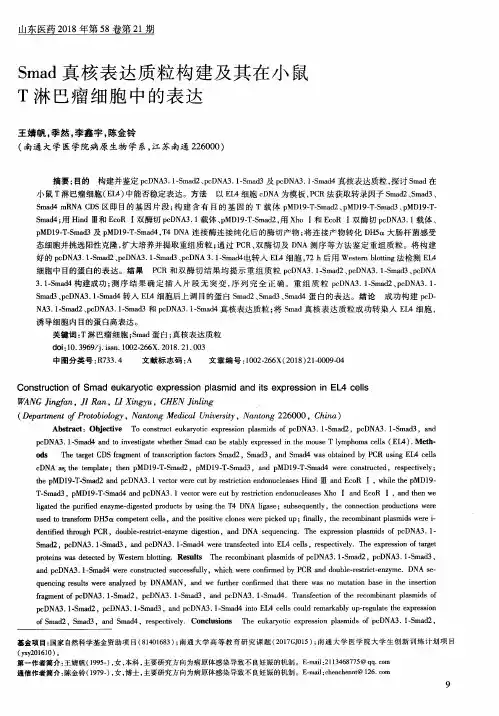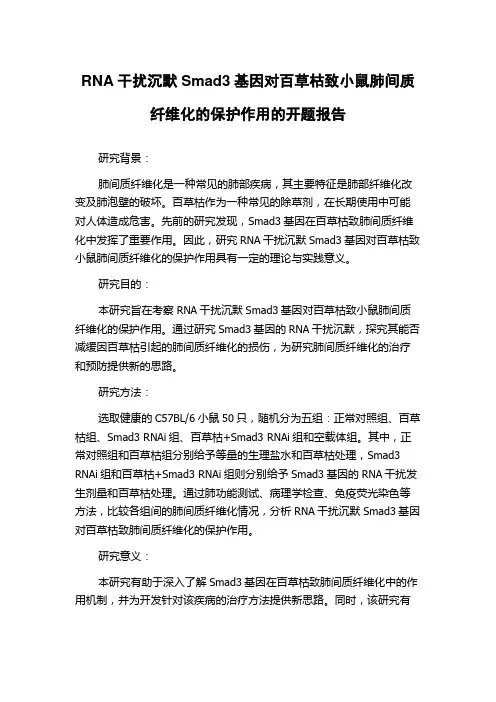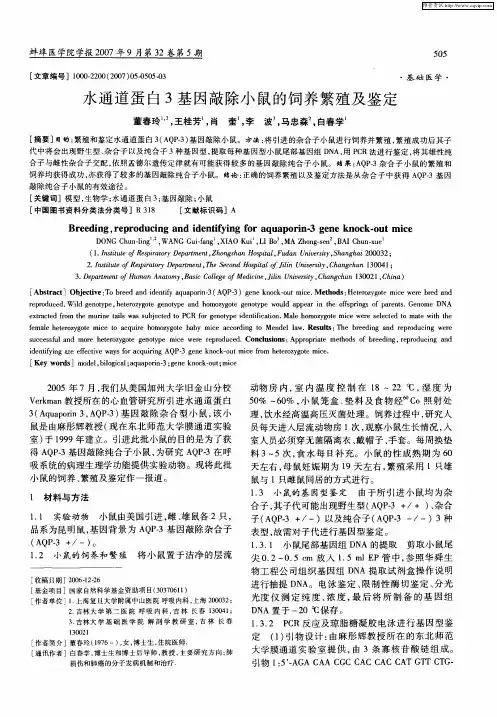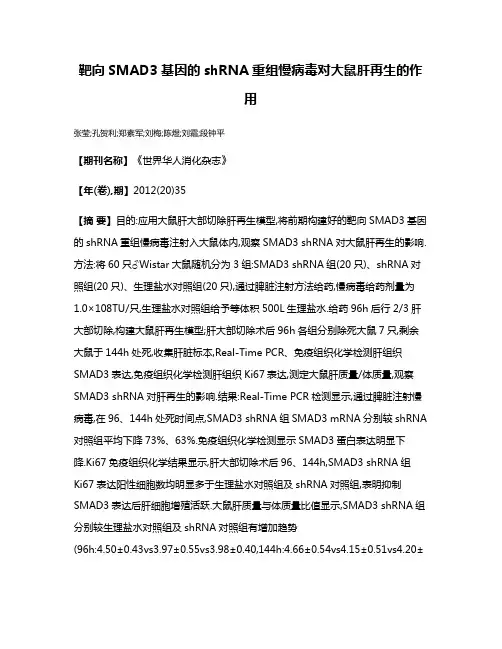Smad3基因剔除小鼠的繁殖与基因型鉴定
- 格式:pdf
- 大小:137.43 KB
- 文档页数:4


RNA干扰沉默Smad3基因对百草枯致小鼠肺间质纤维化的保护作用的开题报告
研究背景:
肺间质纤维化是一种常见的肺部疾病,其主要特征是肺部纤维化改变及肺泡壁的破坏。
百草枯作为一种常见的除草剂,在长期使用中可能对人体造成危害。
先前的研究发现,Smad3基因在百草枯致肺间质纤维化中发挥了重要作用。
因此,研究RNA干扰沉默Smad3基因对百草枯致小鼠肺间质纤维化的保护作用具有一定的理论与实践意义。
研究目的:
本研究旨在考察RNA干扰沉默Smad3基因对百草枯致小鼠肺间质纤维化的保护作用。
通过研究Smad3基因的RNA干扰沉默,探究其能否减缓因百草枯引起的肺间质纤维化的损伤,为研究肺间质纤维化的治疗和预防提供新的思路。
研究方法:
选取健康的C57BL/6小鼠50只,随机分为五组:正常对照组、百草枯组、Smad3 RNAi组、百草枯+Smad3 RNAi组和空载体组。
其中,正常对照组和百草枯组分别给予等量的生理盐水和百草枯处理,Smad3 RNAi组和百草枯+Smad3 RNAi组则分别给予Smad3基因的RNA干扰发生剂量和百草枯处理。
通过肺功能测试、病理学检查、免疫荧光染色等方法,比较各组间的肺间质纤维化情况,分析RNA干扰沉默Smad3基因对百草枯致肺间质纤维化的保护作用。
研究意义:
本研究有助于深入了解Smad3基因在百草枯致肺间质纤维化中的作用机制,并为开发针对该疾病的治疗方法提供新思路。
同时,该研究有
助于评估百草枯对健康的危害程度,为制定更加合理、安全的环境保护政策提供科学依据。



小鼠基因型鉴定方法嘿,你有没有想过,在小鼠这个小小的世界里,科学家们是怎么知道它们的基因类型的呢?这就像是在一个神秘的小宇宙里寻找密码一样有趣呢!今天我就来给大家讲讲小鼠基因型鉴定的方法。
先来说说聚合酶链反应(PCR)吧。
这就像是一个超级放大镜,能把小鼠基因里那些我们想看到的片段放大好多好多倍。
想象一下,小鼠的基因就像是一个超级复杂的拼图,PCR就像是能找到特定几块拼图的魔法工具。
我有个朋友在实验室里做这个,他可有趣了。
他说,“你看啊,这个PCR就像是在基因的海洋里钓鱼,我们设计好特定的引物,就像是特制的鱼钩,专门钓我们想要的那段基因。
”做PCR的时候,要先从小鼠的组织里提取DNA,这就像是从一个装满宝贝的小盒子里拿出最珍贵的东西一样小心翼翼。
提取到的DNA就像是建筑的蓝图,虽然我们看不到整个大厦,但是通过这个蓝图能找到我们想要的部分。
然后把提取的DNA、引物、酶还有一些其他的小助手混合在一起,放到PCR仪这个神奇的小盒子里。
这个PCR仪可不得了,它就像一个魔法厨师,在特定的温度下,一会儿加热,一会儿冷却,让这些东西在里面欢快地反应着。
我曾经好奇地看着这个PCR仪,就想啊,这里面正在发生一场微观世界的狂欢呢!反应结束后,我们就能得到很多很多我们想要的基因片段的拷贝啦。
那怎么知道是不是我们想要的呢?这就需要把这些反应产物跑个电泳。
电泳这个东西啊,就像是一场基因片段的赛跑。
把PCR产物放到凝胶里,通上电,那些基因片段就像一群小运动员一样开始跑起来了。
小的片段跑得快,大的片段跑得慢,最后我们就能看到不同的条带。
如果看到了我们预期的条带,那就像是在比赛里看到自己支持的选手第一个冲过终点线一样兴奋,说明这只小鼠可能就是我们想要的基因型呢!还有一种方法叫基因测序。
这就像是要把小鼠基因这个超级长的故事一个字一个字地读出来。
我问过一个测序的专家,我说:“这得多难啊!”他笑着说:“可不是嘛,但是这就像探索一个未知的宝藏,每一个碱基都是一个小秘密。

靶向SMAD3基因的shRNA重组慢病毒对大鼠肝再生的作用张莹;孔贺利;郑素军;刘梅;陈煜;刘霜;段钟平【期刊名称】《世界华人消化杂志》【年(卷),期】2012(20)35【摘要】目的:应用大鼠肝大部切除肝再生模型,将前期构建好的靶向SMAD3基因的shRNA重组慢病毒注射入大鼠体内,观察SMAD3 shRNA对大鼠肝再生的影响.方法:将60只♂Wistar大鼠随机分为3组:SMAD3 shRNA组(20只)、shRNA对照组(20只)、生理盐水对照组(20只),通过脾脏注射方法给药,慢病毒给药剂量为1.0×108TU/只,生理盐水对照组给予等体积500L生理盐水.给药96h后行2/3肝大部切除,构建大鼠肝再生模型;肝大部切除术后96h各组分别除死大鼠7只,剩余大鼠于144h处死,收集肝脏标本,Real-Time PCR、免疫组织化学检测肝组织SMAD3表达,免疫组织化学检测肝组织Ki67表达,测定大鼠肝质量/体质量,观察SMAD3 shRNA对肝再生的影响.结果:Real-Time PCR检测显示,通过脾脏注射慢病毒,在96、144h处死时间点,SMAD3 shRNA组SMAD3 mRNA分别较shRNA 对照组平均下降73%、63%.免疫组织化学检测显示SMAD3蛋白表达明显下降.Ki67免疫组织化学结果显示,肝大部切除术后96、144h,SMAD3 shRNA组Ki67表达阳性细胞数均明显多于生理盐水对照组及shRNA对照组,表明抑制SMAD3表达后肝细胞增殖活跃.大鼠肝质量与体质量比值显示,SMAD3 shRNA组分别较生理盐水对照组及shRNA对照组有增加趋势(96h:4.50±0.43vs3.97±0.55vs3.98±0.40,144h:4.66±0.54vs4.15±0.51vs4.20±0.34),但没有统计学意义(P>0.05).结论:SMAD3 shRNA在大鼠体内可一定程度上促进肝细胞增殖,但对肝再生的促进作用尚弱.【总页数】8页(P3431-3438)【关键词】SMAD3;shRNA;慢病毒;肝再生【作者】张莹;孔贺利;郑素军;刘梅;陈煜;刘霜;段钟平【作者单位】中国人民解放军第302医院;首都医科大学附属北京佑安医院【正文语种】中文【中图分类】R-332【相关文献】1.靶向大鼠Smad3基因的siRNA筛选及其shRNA重组慢病毒的构建 [J], 陈鹏;郑素军;王世美;张建军;邢欣悦;张莹;刘梅;段钟平2.shRNA 重组慢病毒沉默 SMAD3对大鼠肝纤维化的抑制作用 [J], 张莹;孔贺利;张建军;刘梅;任锋;刘霜;陈煜;段钟平;郑素军3.靶向大鼠诱导型一氧化氮合酶基因的shRNA重组腺病毒载体的构建及鉴定 [J], 袁慧星;王涛;饶可;李明超;李路;刘继红;叶章群4.大鼠靶向α7nAchR基因shRNA真核表达载体及重组腺病毒构建 [J], 王定坤;陆付耳;邹欣;任妍林;董慧;巩静;方珂;徐丽君;王开富5.靶向新城疫病毒NP基因的shRNA重组腺病毒表达载体的构建及鉴定 [J], 杨帆;岳华;侯巍;汤承因版权原因,仅展示原文概要,查看原文内容请购买。

Smad2、Smad3及Smad7蛋白在绝经过渡期大鼠卵巢中的表达及意义摘要:目的:研究Smad2、Smad3及Smad7蛋白在绝经过渡期大鼠卵巢中的表达及其意义。
方法:选取大鼠绝经过渡期卵巢组织,采用免疫组化、Western blot和实时荧光定量PCR方法检测Smad2、Smad3及Smad7的蛋白表达水平,比较其与正常大鼠卵巢的差异,并探讨其与卵巢功能的关系。
结果:在绝经过渡期大鼠卵巢中,Smad2、Smad3及Smad7的蛋白表达水平均显著下调,其中Smad2和Smad3的表达水平下降更为明显(P<0.05)。
与正常大鼠卵巢相比,Smad2、Smad3及Smad7的表达水平显著降低(P<0.01)。
通过对卵巢功能的影响分析发现,Smad2、Smad3及Smad7的下调与卵巢功能下降密切相关。
结论:Smad2、Smad3及Smad7在绝经过渡期大鼠卵巢中均有表达,且表达水平下调,可能与卵巢功能下降有关。
这为研究卵巢衰老机制提供了新思路。
关键词:绝经过渡期;大鼠卵巢;Smad2;Smad3;Smad7;卵巢功能Abstract:Objective: To investigate the expression and significance of Smad2, Smad3 and Smad7 proteins in rat ovaries during menopausal transition.Methods: Rat menopausal transition ovaries were selected, and the protein expression level of Smad2, Smad3 and Smad7 was detected by immunohistochemistry, Western blot and real-time fluorescence quantitative PCR. The differences between them and normal rat ovaries were compared, and the relationship between them and ovarian function was explored.Results: In the ovaries of rats during menopausal transition, the protein expression levels of Smad2, Smad3 and Smad7 were significantly downregulated, with Smad2 and Smad3 showing more significant decreases(P<0.05). Compared with normal rat ovaries, the expression levels of Smad2, Smad3 and Smad7 were significantly reduced (P<0.01). Through the analysis of the influence on ovarian function, it was foundthat the downregulation of Smad2, Smad3 and Smad7 was closely related to the decline of ovarian function.Conclusion: Smad2, Smad3 and Smad7 are expressed inrat ovaries during menopausal transition, and their expression levels are downregulated, which may be related to the decline of ovarian function. This provides a new idea for the study of ovarian aging mechanism.Keywords: menopausal transition; rat ovary; Smad2; Smad3; Smad7; ovarian functionOvarian function is closely linked to the menstrual cycle, which gradually becomes irregular during menopausal transition. As the depletion of ovarian follicles progresses, the production of estrogen and other hormones gradually declines, affecting the regulation of various physiological processes in the female body.In this study, the researchers focused on the expression of Smad proteins, which are involved in the TGF-β signaling pathway, in rat ovaries during menopausal transition. They found that Smad2, Smad3, and Smad7 were expressed in the granulosa and theca cells of rat ovaries, and their expression levels were downregulated as the rats aged.The downregulation of Smad2 and Smad3 has been reported in other tissues during aging, and it may berelated to the dysfunction of tissue repair and regeneration. Smad7, on the other hand, is known toact as a negative regulator of TGF-β signaling, andits downregulation may affect the balance of this pathway in the ovaries.Overall, the findings suggest that the decline of Smad proteins in the ovaries during menopausal transition may contribute to the decline of ovarian function. Further studies are needed to explore the precise mechanisms underlying this phenomenon and itspotential implications for the development oftherapies for menopause-related disordersIn addition to the decline of Smad proteins, other factors may also contribute to the decline of ovarian function during menopause. For example, the decreasein estrogen production by the ovaries is a hallmark of menopause and is associated with a range of symptoms, such as hot flashes, vaginal dryness, and mood changes. Estrogen plays a critical role in regulating thegrowth and development of ovarian follicles, as wellas the production of the female sex hormones progesterone and testosterone. Therefore, the decline of estrogen production during menopause is likely to have a significant impact on ovarian function.In addition to estrogen, other hormones such asfollicle-stimulating hormone (FSH) and luteinizing hormone (LH) may also play a role in menopause-related ovarian dysfunction. FSH and LH are responsible for stimulating the growth and maturation of ovarian follicles, and they are regulated by a complex feedback mechanism involving the hypothalamus,pituitary gland, and ovaries. During menopause, there is an increase in FSH and LH levels due to the decreased sensitivity of the hypothalamus andpituitary gland to negative feedback from the ovaries. This increase in FSH and LH levels may lead to the production of fewer mature follicles and eggs, further contributing to ovarian dysfunction.Other factors that may contribute to menopause-related ovarian dysfunction include oxidative stress, inflammation, and epigenetic changes. Oxidative stress is a condition where there is an imbalance between the production of reactive oxygen species (ROS) and the antioxidant defense mechanisms of cells. ROS can damage cellular components, including DNA, proteins, and lipids, and contribute to cellular dysfunction and aging. Inflammation is a complex biological process that involves the activation of immune cells toprotect the body against pathogens and other harmful stimuli. However, chronic inflammation can lead totissue damage and dysfunction, including in the ovaries.Epigenetic changes refer to modifications to the DNA molecule and associated proteins that can alter gene expression without changing the underlying DNA sequence. These changes can be influenced by environmental factors, such as diet, stress, and exposure to toxins or pollutants. Epigenetic changes may contribute to menopause-related ovariandysfunction by altering the expression of genes involved in ovarian function and aging.In conclusion, menopause-related ovarian dysfunctionis a complex and multifactorial process that involves a range of factors, including the decline of Smad proteins, estrogen production, FSH and LH regulation, oxidative stress, inflammation, and epigenetic changes. Understanding the underlying mechanisms of menopause-related ovarian dysfunction is crucial for the development of effective therapies to manage menopause-related symptoms and improve women's health as they ageIn addition to the physiological changes that occur during menopause, there are also social and psychological factors that can affect a woman'sexperience of this transition. For many women, menopause represents a significant life change that can be associated with feelings of loss, uncertainty, and anxiety. They may feel out of control, uncertain, and alone in their experiences. Education and support from healthcare providers and peers can help to lessen the negative impact of these factors.One of the most common consequences of menopause is an increased risk of osteoporosis, a condition in which the bones become weak and brittle, making them more susceptible to fractures. Women can help to prevent osteoporosis by maintaining a healthy diet that isrich in calcium and vitamin D, engaging in regular exercise, avoiding smoking and excessive alcohol use, and taking medications to prevent bone loss when necessary. Women should also have regular bone density scans to monitor their bone health and identify any changes at an early stage.Another significant health issue that can arise during menopause is an increased risk of cardiovascular disease. Women who have gone through menopause may be more likely to develop high blood pressure, high cholesterol, and other risk factors for heart disease. Lifestyle changes, such as exercise, healthy eating, and stress management, can help to reduce these risks.Women should also work with their healthcare providers to monitor and manage any heart-related problems that may arise during this time.In addition to physical health considerations, menopause can also have a significant impact on a woman's mental health. Many women experience changesin their mood, including anxiety, depression, and irritability, during and after menopause. Hormonal fluctuations, social factors, and psychologicalfactors may contribute to these changes. Women can address these symptoms by seeking support from their healthcare provider, engaging in regular exercise and stress management, getting enough sleep, and considering therapy or other forms of mental health support when necessary.Finally, it is important to acknowledge that menopause is a normal and natural part of a woman's life cycle. While it can be a challenging transition, it can also be an opportunity for growth and self-care. Women should take time to prioritize their own health and well-being during this time, and seek out support from their healthcare providers, friends, and loved ones. By taking a proactive approach to their health and wellness, women can make the most of this transformative time in their livesIn conclusion, menopause is a natural phase in a woman's life that may present challenges but also provides opportunities for self-care and growth. Women should prioritize their health and seek support during this time to make the most of this transformative period. It is essential to approach this stage with a positive mindset and take a proactive approach to maintaining overall health and wellness。

- 160 -*基金项目:国家自然科学基金项目(82260483;81502556);云南省科技厅基础研究专项-重点项目(202301AS070015);云南省消化内镜临床医学中心项目(2022LCZXKF-XH19)①昆明理工大学医学院 云南 昆明 650500②云南省第一人民医院通信作者:郭强SMAD3对消化道恶性肿瘤调控作用的研究进展*李西沙① 唐慧② 刘中建② 郭强② 【摘要】 消化道恶性肿瘤的发生及进展机制一直是国内外研究的热点。
SMAD3作为一种受体调节型蛋白,参与了癌症信号通路,对多数消化道恶性肿瘤的增殖、迁移及侵袭等起着重要的调控作用,与肿瘤患者的预后密切相关。
本文就SMAD3的结构功能、其在消化道恶性肿瘤中的作用机制的最新研究做一综述,以对SMAD3有更全面的了解。
【关键词】 SMAD3 消化道恶性肿瘤 癌基因 Research Progress on the Regulatory Effect of SMAD3 on Gastrointestinal Malignant Tumor/LI Xisha, TANG Hui, LIU Zhongjian, GUO Qiang. //Medical Innovation of China, 2023, 20(36): 160-164 [Abstract] The occurrence and progression mechanism of gastrointestinal malignant tumor have been the focus of research at home and abroad. As a receptor regulated protein, SMAD3 is involved in cancer signaling pathway and plays an important regulatory role in the proliferation, migration and invasion of most gastrointestinal malignant tumor, which is closely related to the prognosis of tumor patients. In this paper, the structure and function of SMAD3 and its mechanism of action in gastrointestinal malignant tumor are reviewed, so as to have a more comprehensive understanding of SMAD3. [Key words] SMAD3 Gastrointestinal malignant tumor Oncogene First-author's address: School of Medicine, Kunming University of Science and Technology, Kunming 650500, China doi:10.3969/j.issn.1674-4985.2023.36.036 肿瘤的发生发展是一个复杂多步骤的生物学过程,多基因参与了肿瘤的调控,在肿瘤的调控网络中存在着一些关键基因。

Smad3基因敲除小鼠肾Smad2和p-Smad2表达的变化吴婧;徐健;董静霞【期刊名称】《解剖学杂志》【年(卷),期】2010(033)001【摘要】目的:观察Smad3基因敲除小鼠肾Smad2和p-Smad2表达的变化,探讨Smad3基因敲除小鼠肾是否有Smad2和p-Smad2代偿性增加.方法:4只Smad3基因敲除小鼠,10只野生型小鼠,应用免疫组织化学显色技术,检测Smad2和p-Smad2蛋白的定位和表达情况,并用Motic病理图像分析系统对图像进行半定量分析.结果:野生型小鼠肾Smad2蛋白在肾远端小管和肾集合管细胞胞质中有广泛弱表达,p-Smad2蛋白在肾远端小管和肾集合管细胞胞质、胞核中也有弱表达,而Smad3基因敲除小鼠的Smad2和p-Smad2的表达比野生型小鼠有显著升高.结论:Smad3基因敲除能引起小鼠肾Smad2和p-Smad2表达的代偿性增加.【总页数】3页(P26-28)【作者】吴婧;徐健;董静霞【作者单位】长江大学医学院组织学与胚胎学系,荆州,434000;北京大学基础医学院解剖学与组织学胚胎学系,北京,100091;北京大学基础医学院解剖学与组织学胚胎学系,北京,100091【正文语种】中文【相关文献】1.霉酚酸酯对UUO大鼠肾间质p-Smad2/3表达的影响 [J], 张浩;唐静;张显明;季迎2.氯沙坦对5/6肾切除大鼠残余肾组织中TGF-β1,p-Smad2/3及Smad7的作用[J], 宁旺斌;胡静;陶立坚;刘春燕;孙剑;肖云;贾爱军3.TGF-β3作用下人牙髓细胞内Smad2、Smad3蛋白表达水平的变化 [J], 包柳郁;牛忠英;史俊南;付进友;汪平4.电针联合两色金鸡菊提取物对糖尿病肾病大鼠肾脏Vimentin、α-SMA、TGF-β1及p-smad2表达的影响 [J], 蒋洁;阿米拉•阿布拉提;姚蓝5.发酵虫草菌粉Cs-4对UUO大鼠肾间质p-Smad2/3表达的影响 [J], 张浩;张显明;唐静;张柯因版权原因,仅展示原文概要,查看原文内容请购买。

Smad3基因剔除的骨髓细胞移植对小鼠的影响陈静;沈红;赵勇【摘要】目的通过小鼠骨髓细胞剔除Smad3基因,观察小鼠病理变化以及免疫T 细胞状态.方法将Smad3基因剔除Smad3~(-/-))的小鼠骨髓细胞和野生型(Smad3~(+/+))小鼠骨髓细胞分别移植给~(60)Co射线照射GFP小鼠.观察骨髓移植后GFP小鼠体征变化,第6周处死小鼠,取肠道固定,HE染色观察其病理变化,流式细胞技术检测淋巴结中T细胞变化.结果移植Smad3~(-/-)骨髓细胞的GFP 小鼠逐渐消瘦,大肠出现炎症;淋巴结中活化型的CD4~+ CD62L~(lo)T细胞增多.结论骨髓细胞TGF-β信号受阻,可导致小鼠患炎症疾病,引起免疫T细胞活化.【期刊名称】《中国实验动物学报》【年(卷),期】2010(018)001【总页数】5页(P9-12,彩3)【关键词】Smad3基因剔除~-;骨髓细胞;T细胞活化;移植【作者】陈静;沈红;赵勇【作者单位】北京农学院动物科学技术系,北京,102206;中国科学院动物研究所生物膜与膜生物工程国家重点实验室,北京,100101;北京农学院动物科学技术系,北京,102206;中国科学院动物研究所生物膜与膜生物工程国家重点实验室,北京,100101;中国科学院动物研究所生物膜与膜生物工程国家重点实验室,北京,100101【正文语种】中文【中图分类】R457.7Sm ad3基因调控S MAD 3表达,S MAD 3是转化生长因子-β(transfor m ing grow th factor-β,TGF-β)受体的底物之一,将TGF-β与其受体结合后产生的信号从细胞质转导到细胞核内[1]。
哺乳动物体内, TGF-β有3种亚型:TFG-β1、TFG-β2和TFG-β3[2]。
TFG-β1主要在免疫系统表达,调节T细胞的发育、稳定、活化以及耐受等[3,4],TGF-β2与TGF-β3在免疫系统表达不稳定[5]。

Smad3基因缺失加快的小鼠皮肤创面收缩速度机制研究毛春明;杨晓;张莉;孙彦洵;侯宁;吕娅歆;黄翠芬【期刊名称】《中国组织工程研究》【年(卷),期】2004(008)026【摘要】目的:研究Smad3基因剔除小鼠皮肤创伤愈合速度加快的机制.方法:利用不同基因型的Smad3基因剔除小鼠及对照小鼠进行皮肤缺失型创伤试验,观察组织病理变化;分离不同基因型小鼠胚胎成纤维细胞,观察其胶原收缩能力的变化.结果:Smad3基因剔除小鼠在皮肤创伤愈合时表现出重上皮化进度快;成纤维细胞胶原收缩试验中,mad3缺失的细胞在有血清的培养条件下胶原收缩速度快于野生型细胞,而在无血清培养条件下,有无转化生长因子β1(TGF-β1)两者变化不显著.有血清培养时Smad3缺失的成纤维细胞表达α平滑肌肌动蛋白(α-SMA)增加.结论:SMAD3通过抑制α平滑肌肌动蛋白在成纤维细胞中的表达调节成纤维细胞的收缩能力,以致Smad3缺失小鼠皮肤创面收缩速度加快.【总页数】3页(P5538-5540)【作者】毛春明;杨晓;张莉;孙彦洵;侯宁;吕娅歆;黄翠芬【作者单位】解放军军事医学科学院生物工程研究所发育和疾病遗传学实验室,北京市,100071;解放军军事医学科学院生物工程研究所发育和疾病遗传学实验室,北京市,100071;解放军军事医学科学院生物工程研究所发育和疾病遗传学实验室,北京市,100071;解放军军事医学科学院生物工程研究所发育和疾病遗传学实验室,北京市,100071;解放军军事医学科学院生物工程研究所发育和疾病遗传学实验室,北京市,100071;解放军军事医学科学院生物工程研究所发育和疾病遗传学实验室,北京市,100071;解放军军事医学科学院生物工程研究所发育和疾病遗传学实验室,北京市,100071【正文语种】中文【中图分类】R349.8【相关文献】1.Lgr6基因质粒转染人脐带间充质干细胞对小鼠皮肤创面的修复作用 [J], 石胜军;陈广平;贾思远2.血脂异常ApoE基因缺失小鼠视网膜血管瘤增生及其机制研究 [J], 王毅;巫娟;李罗翔;李娟;曾庆华;刘小虎;3.血脂异常ApoE基因缺失小鼠视网膜血管瘤增生及其机制研究 [J], 王毅;巫娟;李罗翔;李娟;曾庆华;刘小虎4.转hCTLA4-IgG基因小鼠移植皮肤在糖尿病大鼠创面存活的延长 [J], 王勇;葛良鹏;倪勇;刘勤;魏泓5.小鼠Smad3基因的克隆及其在小鼠组织中的表达 [J], 程萱;徐晓玲;沈善祥;周江;邓初夏;杨晓因版权原因,仅展示原文概要,查看原文内容请购买。
广西医科大学学报JOURNAL OF GUANGXI MEDICAL UNIVERSITY2020Aug ;37(8)CRISPR/Cas9介导Smad3基因敲除对人腹膜间皮细胞增殖和凋亡的影响*梁靖梅,李福记,林鹏,廖蕴华△(广西医科大学第一附属医院肾内科,南宁530021)摘要目的:以CRISPR/Cas9基因编辑技术,构建Smad3基因敲除的人腹膜间皮细胞(HPMC ),研究Smad3在HPMC 增殖和凋亡中的调控机制。
方法:利用CRISPR Design 软件设计gRNA ,比对后合成,构建Smad3gRNA-PX459质粒,用Lipo-fectamine 3000转染细胞,嘌呤霉素筛选后用有限稀释法获得单克隆细胞株,提取DNA 进行PCR 扩增后测序,同时提取总蛋白,采用蛋白免疫印迹(Western blotting )检测蛋白表达情况;CCK8法检测细胞增殖情况,流式细胞术检测细胞凋亡率,West-ern blotting 检测凋亡相关蛋白表达。
结果:成功构建Smad3稳定敲除的HPMC 。
Smad3基因敲除后,细胞增殖率无明显变化(P >0.05),而凋亡率从(7.92±0.26%)上升至(11.70±0.56%),促凋亡相关蛋白Bax 表达量从(0.70±0.05)上调至(1.25±0.11)(P <0.05)。
结论:Smad3基因在HPMC 的凋亡中具有重要的调控作用。
关键词Smad3基因;CRISPR/Cas9;人腹膜间皮细胞中图分类号:R692.5文献标志码:A文章编号:1005-930X (2020)08-1398-06DOI :10.16190/ki.45-1211/r.2020.08.002Effects of CRISPR/Cas9-mediated Smad3gene knockout on proliferation and apoptosis ofhuman peritoneal mesothelial cellsLiang Jingmei,Li Fuji.Lin Peng,Liao Yunhua.(Nephrology Department,The First Affiliated Hospital of Guangxi Medical University,Nanning 530021,China)AbstractObjective:To construct Smad3gene knockout of human peritoneal mesothelial cell (HPMC)byCRISPR/Cas9gene editing,and to study the regulatory mechanism of Smad3in HPMC proliferation and apopto-sis.Methods:The gRNA,was designed and synthesized by CRISPR Design software,and the Smad3gRNA-PX459plasmid was constructed.The cells were transfected with Lipofectamine 3000,and the monoclonal cell lines were obtained by limiting dilution method after puromycin screening.DNA was extracted for PCR amplifi-cation,and the total protein was extracted at the same time.The protein expression was detected by Western blot-ting.The cell proliferation was detected by CCK8method,the apoptosis rate was detected by flow cytometry,and the expression of apoptosis-related protein was detected by Western blotting.Results:The HPMC of Smad3sta-ble knockout was successfully constructed.After Smad3gene knockout,there was no significant change in cell proliferation rate(P >0.05),but the apoptosis rate increased from (7.92±0.26%)to (11.70±0.56%),and the expres-sion of apoptosis-related protein Bax was up-regulated from (0.70±0.05)to (1.25±0.11)(P <0.05).Conclusion:Smad3gene plays an important role in the regulation of HPMC apoptosis.Keywords Smad3gene;CRISPR/Cas9;human peritoneal mesothelial cells*基金项目:国家自然科学基金资助项目(No.81660133);广西自然科学基金资助项目(No.2018GXNSFAA050047)△通信作者,E-mail :**********************收稿日期:2020-05-20腹膜透析是终末期肾病(end-stage renal dis-ease ,ESRD )患者的重要替代疗法之一[1-2]。
Smad3基因剔除对小鼠造血功能的影响张玲;孙昭;沈爱玲;马丽;姜学英;马冠杰;杨晓;赵春华【期刊名称】《生物工程学报》【年(卷),期】2003(019)004【摘要】研究Smad3基因剔除对小鼠造血功能的影响.实验小鼠分为5组,每组有Smad3基因剔除小鼠(Smad3-/-)和其同窝孪生的野生型小鼠(Smad3+/+)各1只.小鼠的造血功能用14天形成的脾结节(CFU-S14)、多系祖细胞(CFU-GEMM)、粒-单系祖细胞(CFU-GM)、红系祖细胞(BFU-E)测定及外周血象、骨髓象等实验血液学指标来确定.每组小鼠取尾血作白细胞、红细胞和血小板计数,涂片作白细胞分类计数.将一侧股骨的骨髓冲出,制成单细胞悬液,计数其中有核细胞数,测定CFU-GM、BFU-E、CFU-GEMM值.将每只小鼠的4×104个骨髓有核细胞,经尾静脉注入3只8~10周经致死量射线照射的同系雌性小鼠体内,测定14天的CFU-S.取一部分胸骨、肝脏、脾脏固定做病理切片,其余胸骨冲出骨髓,涂片作分类计数.结果Smad3-/-小鼠外周血白细胞和血小板计数明显高于Smad3+/+小鼠,红细胞数无显著差异.外周血白细胞分类结果也表明粒细胞显著增高.骨髓有核细胞数无显著差异,CFU-GM显著增高,BFU-E 无显著差异,CFU-GEMM明显减少,CFU-S显著减少.病理形态学观察发现骨髓增生极度活跃,以粒系为主,肝脾无显著差别.骨髓涂片分类表明粒系增多,粒系:红系比例增高.因此得出结论Smad3基因剔除使小鼠造血干祖细胞数目减少,而且干祖细胞分化异常,向粒系分化增多.Smad3基因对造血系统的作用与TGF-β的作用有相关性.【总页数】5页(P428-432)【作者】张玲;孙昭;沈爱玲;马丽;姜学英;马冠杰;杨晓;赵春华【作者单位】中国医学科学院中国协和医科大学,血液学研究所,实验血液学国家重点实验室,天津,300020;中国医学科学院中国协和医科大学,血液学研究所,实验血液学国家重点实验室,天津,300020;青岛市人民医院;中国医学科学院中国协和医科大学,血液学研究所,实验血液学国家重点实验室,天津,300020;中国医学科学院中国协和医科大学,血液学研究所,实验血液学国家重点实验室,天津,300020;中国医学科学院中国协和医科大学,血液学研究所,实验血液学国家重点实验室,天津,300020;军事医学科学院生物工程研究所,发育和疾病遗传学研究室,北京,100071;中国医学科学院中国协和医科大学,血液学研究所,实验血液学国家重点实验室,天津,300020【正文语种】中文【中图分类】Q813【相关文献】1.Smad3基因剔除的骨髓细胞移植对小鼠的影响 [J], 陈静;沈红;赵勇2.Smad3基因剔除小鼠血清酶活性的变化 [J], 孙岩松;王冬平;杨晓;李文龙;栾蓉晖;战大伟;李吉庆;时彦胜;赵德明3.Smad3基因剔除小鼠的繁殖与基因型鉴定 [J], 孙岩松;吕雅歆;时彦胜;战大伟;李文龙;张爱兰;杨晓4.Smad3基因剔除对小鼠肾脏功能的影响 [J], 王冬平;孙岩松;杨晓;李文龙;栾蓉晖;战大伟;李吉庆;时彦胜;李桂军;张爱兰5.Smad3基因剔除导致小鼠发生骨质疏松 [J], 李文龙; 谭晓红; 张继帅; 杨蕾蕾; 孙岩松; 杨晓因版权原因,仅展示原文概要,查看原文内容请购买。
中国畜牧兽医 2019.46(1):185 193China Animal Husbandry & Veterinary MedicineSMAD3基因在畜牧生产中的应用研究进展谭 斌⑺,杨胜林2**,杨汝才⑺,王旭平1.2,周美迪1,2,周 璇3,杨世皓1.2收稿日期:2018-07-10基金项目:贵州省科技厅成果应用与产业化计划(黔科合成果[2017]4110、黔科合成果[2018]4301);贵州省科技厅科技支撑计划(黔科合NY[2015]3006-2、黔科合支撑[2017]2539);贵州省普通本科高等学校科技成果转化与产业化(黔教合KY 字[2017]056)作者简介:谭 斌(1993-),男•贵州普定人,硕士生,研究方向:特种经济动物饲养,E-mail :364100279@qq. com*通信作者:杨胜林(1963-),贵州岑巩人,博士,教授,研究方向:动物遗传育种与繁殖、特种经济动物饲养,E-mail :shenglinyan g @ 126. com(1.贵州大学动物科学学院,贵阳550025 ;2.高原山地动物遗传育种与繁殖教育部重点实验室,贵阳550025)摘 要:SMAD3基因是SMADS 基因家族成员之一,其编码的SMAD3蛋白是转化生长因子-p (TGF-|3)超家族特异的细胞内信号转导分子,SMAD3基因通过TGF-R 超家族参与疾病、免疫调节、生长发育、创伤愈合、软骨与骨骼 的发育及维持等重要的生理过程,同时还参与调节生殖细胞的增殖、分化、成熟、黏附、闭锁、凋亡和窗体激素的产生等,因此,了解SMAD3基因的结构与功能对动物生长发育、繁殖等研究具有重要意义。
文章简述了 SMAD3基 因结构、功能、作用机理,分析了其在畜牧生产方面相关的应用研究进展发现,目前SMAD3基因在畜牧生产上的应用研究主要集中在参与调控脊椎动物(猪、牛、羊、鸡等)生长、发育、细胞免疫与凋亡、激素分泌及繁殖功能方面;SMAD3基因在调控动物机体疾病发生、生长发育、脂肪沉积及繁殖性能方面仍是国内外研究的热点,而该基因对畜禽疾病发生、生长和繁殖性能的精确分子调控机制仍有待进一步研究。
研究Smad3基因在猪卵母细胞成熟过程中的表达特征-基因工程论文-生物学论文——文章均为WORD文档,下载后可直接编辑使用亦可打印——动物卵母细胞体外成熟(IVM)、体外受精(IVF)、卵胞浆内单精子注射(ICSI)和克隆等技术是动物胚胎工程的主要研究内容之一。
近年来,家畜卵母细胞的体外成熟培养技术得到进一步提高,不仅为家畜胚胎生物技术提供了大量卵源,同时也是研究卵母细胞发生和发育规律的有效手段,但仍存在卵母细胞的成熟率、卵裂率及其囊胚发育率低等问题。
为解决这一难题,秦鹏春等进行了大量的研究工作,认为FSH和LH这两种激素对猪卵母细胞IVM和排卵起到至关重要的作用.SMAD3是TGF-(transforming growth factor )的下游受体激活蛋白。
TGF-超基因家族是在卵泡的生长、发育、闭锁及卵细胞的成熟和甾体激素的产生等方面都有重要的作用.SMAD3是其下游信号传导分子,TGF-首先与TGF-I(ITGF-receptor typeII)结合,迅速磷酸化TGF-I (TGF-receptor typeI),继而激活SMAD3使其磷酸化,并与SMAD4结合转移入核,调节靶基因的功能.有大量实验表明,TGF-/Smads通路对卵泡的发育、颗粒细胞的增值有重要作用,其变化可影响内分泌激素的作用,从而影响卵巢的功能.开发优良家畜的生殖潜能,直接为社会提供优质的生殖配子或胚胎,必将创造更大的经济和社会价值。
因此,本实以猪卵做研究对象,研究Smad3基因在猪卵母细胞成熟过程中的表达特征,为阐明Smad3基因与卵母细胞体外成熟的关系奠定基础。
1 材料与方法1.1 材料猪卵巢来自青岛市即墨屠宰场的青年母猪。
采集卵巢后将其放入盛有青霉素、链霉素的37℃生理盐水保温瓶中,2 h内送回实验室进行卵母细胞的收集。
将分别培养到0、24、36 h和48 h的COCs 进行透明质酸酶消化,去除卵母细胞周围的颗粒细胞,Hoechst染色后在倒置显微镜下观察各个不同时期的细胞形态。